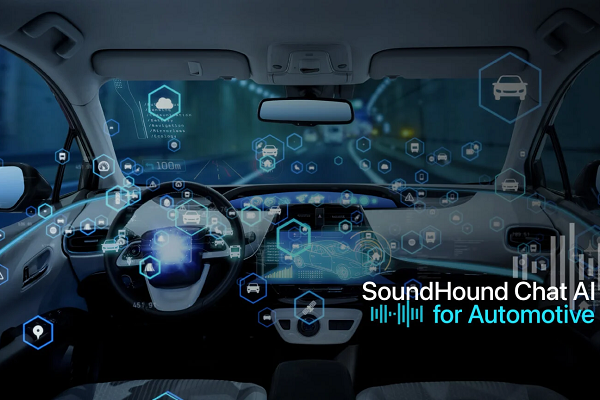SoundHound Exports Generative AI Voice Chat to Cars

SoundHound’s new generative AI voice assistant is coming to cars after launching on mobile apps last month. The new SoundHound Chat AI for Automotive allows drivers to converse by voice with generative AI models like ChatGPT, augmented by an established voice assistant supported by SoundHound.
SoundHound Auto Generative
SoundHound Chat AI for Automotive builds on the company’s existing generative AI integration linking SoundHound’s voice AI technology to third-party large language models like OpenAI’s GPT-4, the model behind ChatGPT. The car serves as a kind of domain-specific database for the generative AI and relies on the same Conversational AI Language (CaiLAN) and Conversational AI Network (CaiNet) systems created by SoundHound as that platform. Local knowledge, such as nearby businesses, traffic, and weather, is provided by CaiLAN, while CaiNET surveys the available databases to decide which are relevant for answering user queries. CaiNET also serves as a filter to weed out any incorrect or confusing ‘hallucinations’ generated by the AI as a response. SoundHound had quietly begun testing CaiLAN and CaiNET for cars as well as restaurants as part of its Dynamic Interaction voice AI for business services. SoundHound COO Michael Zagorsek outlined how it works in an interview with Voicebot about the company’s generative AI plans.
“Speaking is much faster as an input than typing. Reading may be better than listening, but [SoundHound’s platform] can do it all hands-free,” Zagorsek said. “Voice interaction is going to be the best way to tap into some of the LLMs and generative AI, but in a voice environment, you need multiple data sources. The platform is ideal for routing [queries] to the appropriate data source to generate an answer. Our natural language understanding and real-time speech-to-meaning let [the AI] knows pretty early on during the query which database to pick. SoundHound uses parallel tracking – so we are confident our system can handle queries and make sure that [the assistant] doesn’t have a nonsensical result.”
Drive AI
SoundHound announced the new AI option in tandem with the results of a survey about what technology drivers prefer or want to try. Half of the regular drivers in the 1,008-person study are interested in adding generative AI features to an in-car voice assistant, with the percentage rising to 75% for drivers who often use a car voice assistant already. A sizeable number of those who don’t use their car voice assistant much, if at all, right now are interested in generative AI, with 28% likely or somewhat likely to do so. As for what generative AI-powered assistants could do that a current voice assistant might struggle with, SoundHound said there’s demand for more complex conversation on local traffic laws, vehicle maintenance, and local attractions and scenic drives.
The generative AI features are part of SoundHound’s growing automotive portfolio, most recently integrating its voice AI into the Harman Ignite Store for cars. Last year, SoundHound became a feature for Dongfeng Peugeot Citroën Automobiles (DPCA) vehicles in China, its first Mandarin language outlet. The deal grew out of SoundHound’s recent contract with DPCA’s parent brand Stellantis in Europe and incorporates its custom wake words and Edge+Cloud connectivity options combining on-device and cloud processing. The company also counts Hyundai, Kia, and Mercedes among its vehicular clients.
Follow @voicebotaiFollow @erichschwartz
SoundHound Launches Generative Chat AI Voice Assistant Platform and Mobile App
SoundHound Adds Generative AI Access to Voice Assistant Platform








